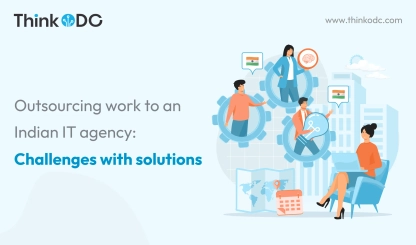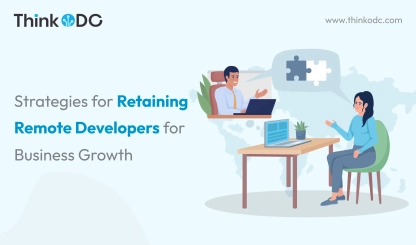As you add more customers, expand your business into new markets, or roll out additional products and services, it’s only natural that your internal resources get stretched thin. Because of that, it becomes difficult for you and your team to handle the extra workload. And If you try, you may have to sacrifice quality or delivery timelines.
In such situations, many business leaders consider utilising external resources through outsourcing or outstaffing.
But in these two models, how do you decide which option would suit your specific business needs better?
That’s what we’ll find out in this post. We’ll dig into what exactly outsourcing and outstaffing mean, weigh their respective pros and cons, and provide tips on choosing the right model for your unique situation.
What is outstaffing?
Imagine this: An experienced developer who was in charge of some very important development tasks has unexpectedly left the team. Because no one is to take his place, you are having problems meeting deadlines, being productive, and other things. You know that hiring in-house developers will require a significant amount of time and effort, but you have to close the gap as soon as possible. What would you do?
Outstaffing saves the day in this situation.
Through outstaffing you can hire dedicated developers ready to work directly for your company, even if they're halfway across the globe.
So, what is outstaffing exactly?
Outstaffing is the process of hiring qualified professionals from a specialized offshore development agency to carry out your company's job responsibilities remotely. These experts work on a temporary or long-term basis for you, but the agency handles all hiring, taxes, payroll, and other HR functions.
Think of it as expanding your in-house team virtually, with the offshore agency serving as your trusted talent scout and HR department rolled into one.
So, how does it work?
You tell the outstaffing company what kind of specialist you need – a software developer, a UI/UX designer, a data analyst – and they scour their global talent pool to find the ideal candidate.
After that, the agency shares the list of candidates, their details and portfolios with you for further processing. Once you select the ideal candidate for the role, they are seamlessly integrated into your projects and reporting structure.
In this entire process, the agency handles all the background admin and legalities.
Now that you know about outstaffing and how it works, let's delve into the pros and cons of this model:
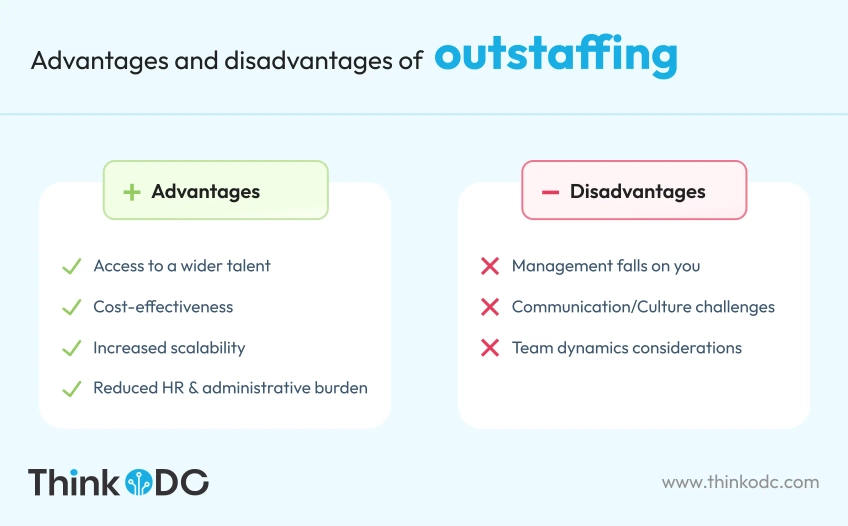
Some key advantages of outstaffing include:
-
Access to a wider talent pool: Instead of being limited to candidates who apply directly to your openings, outstaffing gives you access to entire agencies’ networks of pre-vetted professionals. This significantly expands your options.
-
Cost-effectiveness: Compared to the overhead required for full-time hires, outstaffing delivers specialized skills at a fraction of the cost. Agencies handle sourcing, screening, payroll, benefits, and other complexities.
-
Increased flexibility and scalability: Scale team size and composition up or down to match workloads. Outstaffing is ideal for covering fluctuating business needs.
-
Reduced HR and administrative burden: With staffing partners overseeing the bulk of HR-related tasks, your own team can focus more on core operations.
Potential downsides to weigh include:
-
Management falls on you: While external agencies handle a lot of the heavy lifting, overseeing and directing any outstaffed workers still falls squarely on your shoulders.
-
Communication/culture challenges: Outstaffed team members may struggle to seamlessly integrate with full-time staff. Some accommodation around work culture and communication norms may be required.
-
Team dynamics considerations: Be thoughtful about how you onboard outstaffed employees and acclimate them to any established team workflows to minimize friction.
Outstaffing provides unmatched talent access and resource flexibility. However, effective communication strategies and dedicated management are vital to overcoming key challenges like cultural gaps.
When executed well, it's a strategic growth enabler. Now let's discuss outsourcing.
What is outsourcing?
So you've discovered the secret to outstaffing, allowing you to hand-pick talent from a global pool. Outsourcing, on the other hand, is not the same as outstaffing.
Consider the following: You have an excellent development team, but everyone is preoccupied with one or more projects. You now have a project or piece of work that needs to be completed right away, but you don't have time to hire more developers. What would you do in this situation?
Outsourcing can help here.
So, what precisely is outsourcing?
Outsourcing is a type of offshore development where an organization (client) hires another company, specifically a software development outsourcing company, and outsources their entire software project or part of it to them.
It's like handing over a complex task or project to a team of experts and having them complete it while you focus on running your business.
Now, let's delve into the advantages and disadvantages of outsourcing:
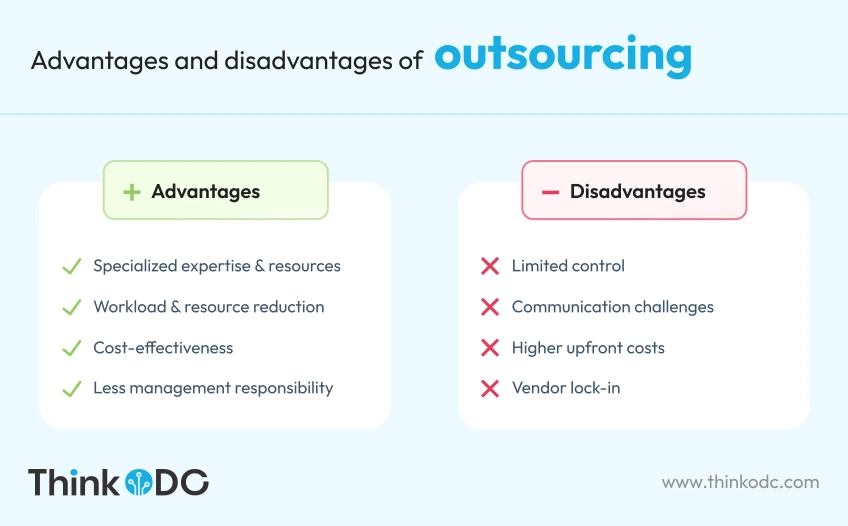
Advantages of outsourcing include:
-
Access to specialized expertise and resources: Offshore vendors maintain vast expertise covering highly complex or niche disciplines. Tapping into these robust skill sets can be extremely beneficial.
-
Workload and resource reduction: Outsourcing non-critical areas of operations frees you to re-invest more time and energy in priorities better aligned with strategic goals.
-
Cost-effectiveness for specific functions: Tasks requiring significant upfront or fixed investments like software development may prove more budget-friendly to outsource than handle in-house.
-
Less management responsibility: Beyond defining desired deliverables/outcomes, vendors take full accountability for executing outsourced work.
The downsides of outsourcing potentially involve:
-
Limited control: You must relinquish some direction over how tasks are completed when fully handing them off to an outside party.
-
Communication challenges: Cultural barriers, lack of visibility, and assorted friction can complicate collaboration with offshore teams.
-
Higher upfront costs: Although fixed or project-based outsourcing fees seem cheap at face value, they often exceed the incremental costs of tackling work in-house over time.
-
Vendor lock-in: Transitioning to new vendors for critical functions without business disruption is easier said than done after the initial handoff occurs.
Outsourcing trades off some loss of control for access to turnkey expertise, resources and cost savings. To maximize its advantages while minimizing risks around communication and switching barriers, meticulous vendor selection, contracting and relationship management are required.
The choice between outsourcing Vs outstaffing depends largely on the scope, duration and intricacies of the tasks at hand.
Read More: In-House vs IT outsourcing - discover which one is right for your business
Outstaffing vs outsourcing: the basic difference
Here’s a quick comparison between these two models:
| Element | Outstaffing | Outsourcing |
|---|---|---|
| Responsibility | Yours. You manage and direct the outstaffed developers who become part of your team. | Vendor's. You hand over the entire project or function to the offshore vendor, who takes ownership of its success. |
| Control | High. You set the goals, provide direction, and closely monitor progress. | Moderate. You influence the project through communication and milestones, but the vendor manages daily operations. |
| Management | You handle it. You manage all the tasks and give them responsibilities. | Vendor handles it. They manage their team, handle internal processes, and report progress to you. |
| Resource Allocation | Flexible. You can easily scale your team up or down with additional offshore developers as needed. | Project-based. You allocate resources for the duration of the specific project or function being outsourced. |
| Cost Structure | Variable. Based on the number of professionals hired and their skill sets. Can be more cost-effective than direct hiring for long-term needs. | Fixed or pre-defined. Negotiated upfront and often involves project fees or retainer agreements. Can be higher for complex projects. |
Outstaffing vs outsourcing: which to choose for your business?
Now you know how outstaffing vs outsourcing differ from each other, but do you know among the both model which one is right for you?
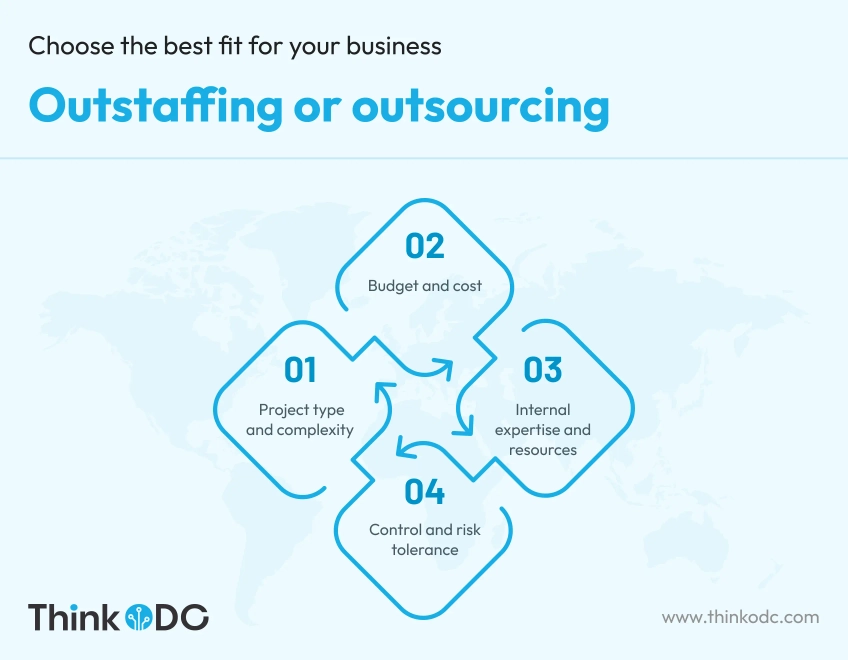
Let's break it down.
Project type and complexity:
Ongoing needs: If you require long-term support for tasks like help desk, system administration, network monitoring or any other, outstaffing might be a better fit. You gain a dedicated team that integrates into your IT environment.
Specific projects: For well-defined IT projects with clear timelines, like software development or infrastructure upgrades, outsourcing can be more efficient. You leverage the vendor’s expertise without the long-term commitment of managed services.
Budget and cost:
Flexibility: With outstaffing you get the power to scale up and down the strength of your team as per the requirement, which gives you cost flexibility.
Fixed costs: In outsourcing, you hand over your overall project to the offshore development team, which often involves fixed fees. It means outsourcing lets you predict the budget. However, you might face upfront vendor costs for the initial setup.
Internal expertise and resources:
Filling skill gaps: If you need to fill specific skill gaps in your team, outstaffing is the best option. Outstaffing allows you to hire developers with expertise that your team lacks, without having to invest in internal training or infrastructure.
Leveraging existing capabilities: If your team already has strong skill sets for certain tasks, consider outsourcing complex project components that require specialised expertise beyond your team's capacity.
Control and risk tolerance:
Direct control: Outstaffing offers greater control over project execution and individual performance. You manage the team directly and can provide immediate feedback for course correction.
Trusting the expertise: Outsourcing requires relinquishing some control, trusting the vendor to manage their team and delivering the desired outcomes based on your agreed-upon specifications.
Outstaffing and outsourcing both empower businesses in unique ways. The ideal approach depends heavily on aligning with the budget, risk appetite, existing skills, and management involvement required. Analyze where your needs and constraints fall across these spectra to make the optimal vendor selection.
Final words
Determining whether outstaffing or outsourcing makes the most sense depends entirely on your specific internal capacity needs, budgets, and risk tolerance. Outstaffing offers more affordable, nimble talent scaling, while outsourcing enables accessing specialized expertise entirely externally.
With the right approach, leveraging external talent and partners enables focus on core priorities to drive growth.
So, If you think outstaffing is the ideal solution for you, go ahead with that. You can partner with ThinkODC, a reputed outstaffing service provider known for delivering top-notch talent. Their expertise in connecting businesses with skilled professionals can improve the capabilities of your team, allowing you to tackle projects more efficiently and achieve your objectives.
If you believe that outsourcing will solve your problem, you can collaborate with Peerbits. A custom software development company with a proven track record of delivering high-quality solutions to diverse clients. With over 12 years of experience in software development and IT outsourcing, they have the ability to handle your unique needs.


